Delicious simmered kabocha squash flavored with the popular Japanese seasoning shio koji (rice koji and salt), resulting in a unique umami flavor.
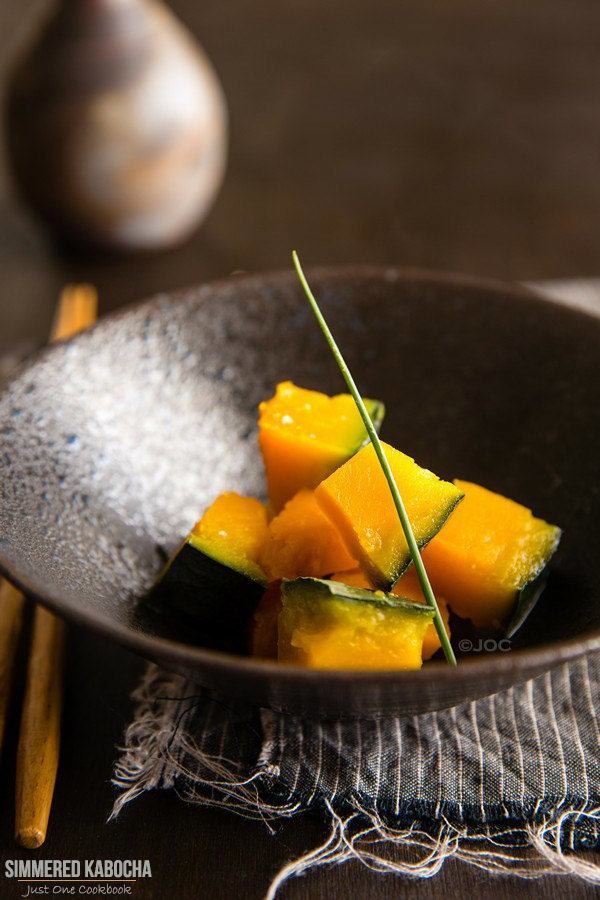
Have you tried Kabocha (カボチャ, 南瓜) before? It’s called Kabocha squash in the U.S. and Japanese pumpkin in Australia and New Zealand. This simmered kabocha is one of the easiest way to cook kabocha, and of course it is super delicious!
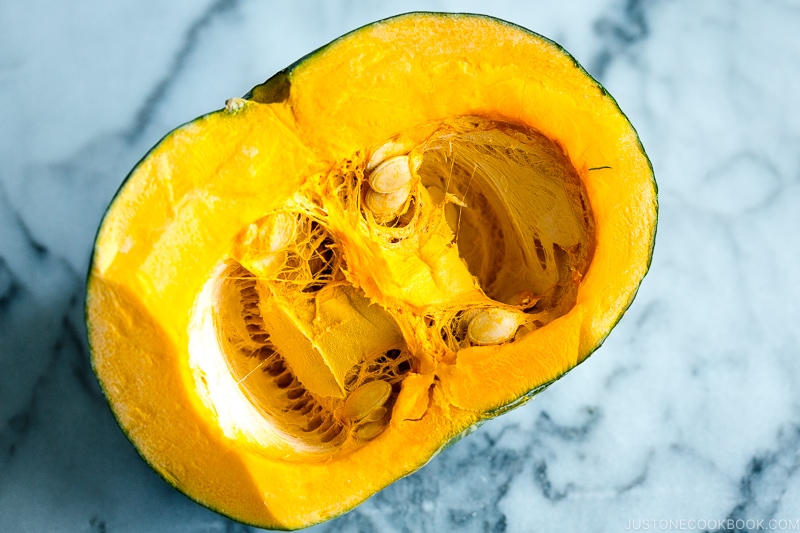
What is Kabocha?
Kabocha is an Asian variety of winter squash, but in Japan, we refer to it as simply pumpkin. Kabocha’s exterior and texture is very hard when it’s raw, and has thick deep green skin. I know it’s not particularly “pretty.” But when you cut it open, (it will require some strength to cut through), you will see a beautiful intense yellow-orange flesh inside.
Kabocha is very moist and has a chestnut-like fluffy texture. It’s also filled with beta-carotene (which is converted to vitamin A by our body), iron, vitamin C, and B.
Simple and Delicious Simmered Kabocha
Because kabocha is naturally very sweet, and sweeter than butternut squash, a nice way to enjoy the kabocha’s natural flavor is to simmer it with minimum seasonings. For this recipe, I used only Shio Koji (塩麹), which brings out nice umami from kabocha.
Shio Koji
Shio koji is a traditional Japanese ingredient made with fermented rice malt (koji) and salt (shio). The enzymes contained in shio koji break down proteins to draw umami out of meat and fish. If you want to read more about it, click here.
To get the Simmered Kabocha with Shio Koji recipe, click here over at Hikari Miso’s website.
Where to Find Shio Koji for Simmered Kabocha?
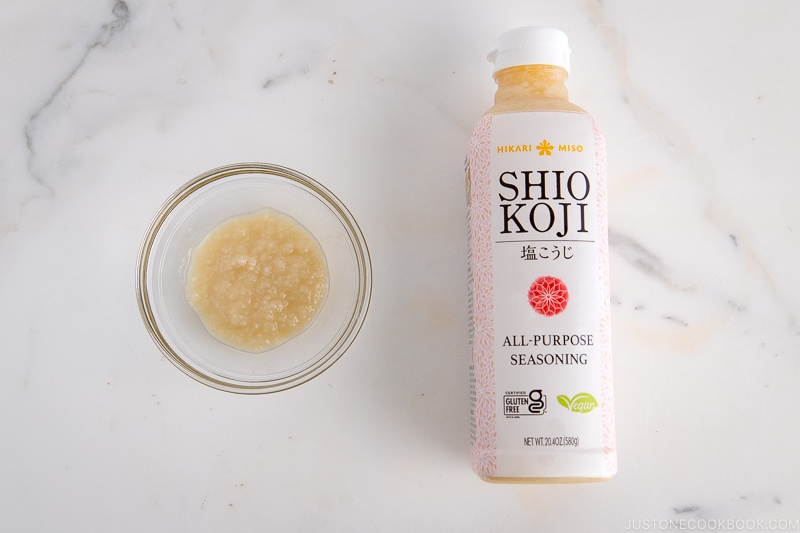
I use shio koji from Hikari Miso and their products are available in Japanese grocery stores and on Amazon.
If you want to make Homemade Shio Koji, watch this short video below. For the step-by-step recipe, click here.
Other Delicious Kabocha Recipes
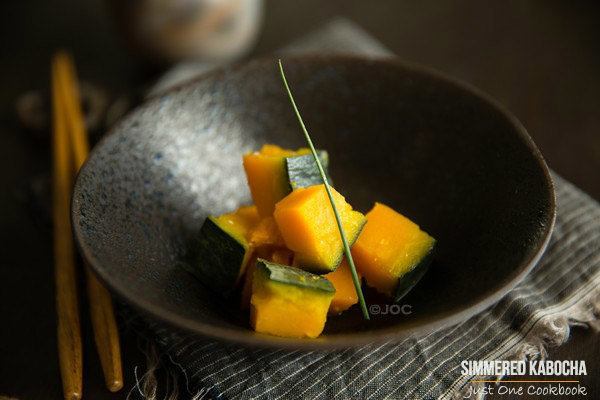
Wish to learn more about Japanese cooking? Sign up for our free newsletter to receive cooking tips & recipe updates! And stay in touch with me on Facebook, Pinterest, YouTube, and Instagram.
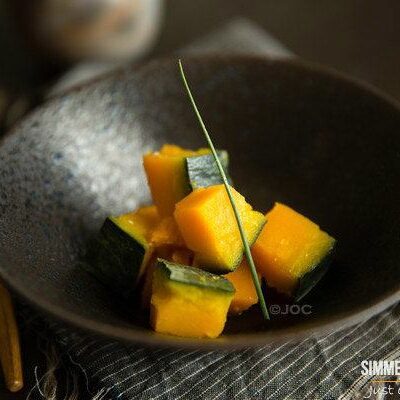
Simmered Kabocha with Shio Koji
Ingredients
- 12 oz kabocha squash
- 1 Tbsp Hikari Miso Shio Koji (or substitute 2 tsp kosher salt)
- water
Instructions
- Cut 12 oz kabocha squash into 1-inch (2.5-cm) chunks. Put them in a medium saucepan.
- Add just enough water to completely cover the kabocha. Then, add 1 Tbsp Hikari Miso Shio Koji.
- Bring to a boil, then lower the heat to a simmer. Cook the kabocha until a skewer goes through smoothly, about 4–5 minutes. Take the pot off the heat.
- Cover with a lid and set aside to allow kabocha to slowly absorb the shio koji flavor. The residual heat will continue to slowly cook the kabocha squash during this time. If you overcook the kabocha squash, it will get mushy and lose its shape and appeal. You can serve this dish cold, at room temperature, or warm.
Nutrition
Editor’s Note: The post was originally published on February 9, 2014.










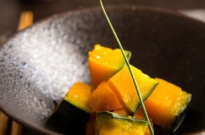
Creamy mashed potatoes with shio koji was a big hit at our thanksgiving dinner.
Thanks!
I am looking forward to trying your simmered kabocha recipe now that I have a supply of the shio koji
Hi Rodney!
Thank you very much for trying Creamy Mashed Potatoes with Shio Koji https://www.justonecookbook.com/mashed-potatoes-with-shio-koji/.
We are so happy to hear everyone enjoyed it!
We hope you will like this Kabocha recipe too. 🙂
Happy Thanksgiving!
About how long do you leave it to sit and cook in the residual heat? I have made this recipe many times in the past few years but I always seem to either over or under cook it! Thank you, arigato gozaimasu !
Hi Elizabeth,
Thank you so much for trying this recipe!
We recommend to leave it covered with a lid for 15~20 or longer. The longer you leave it, the Kabocha absorbs flavor from the Shio Koji. As Nami mentioned it in the recipe Step 3, please make sure to cook the kabocha until a skewer goes through smoothly, before you take out from the stove to avoid undercooking.
I hope this is helpful.
A perfect fall salad! Delicious and so easy to make! I cook my kaboucha whole in my Instant Pot it makes it so much easier to clean and cut off the skin afterwards.
Thank you for the recipe!
Hi Kim! Thank you for your kind feedback. I’m so happy to hear you enjoyed this recipe! 🙂
[…] Shio Koji Simmered Kabocha […]
[…] Simmered Kabocha with Shio Koji […]
Wow, such a simple & tasty recipe. I recently saw some shio koji at my local Japanese grocery store. I recalled instantly that you got recipes for those so i bought a bottle.
Btw Nami san, do you happen to know the small square & heavy japanese tabletop charcoal grill? I saw 1 at Aeon when i was in Okayama and wanting to buy it but didn’t coz my suitcase already full & heavy. Next time i’d like to buy but don’t know the japanese name for it.
Thanks
Hi Ima! It’s called Shichirin 七輪, but there are different types. If I’m honest, it’s great for a Japanese ryokan (hotel) to serve a single dish to a guest, but for home use, it’s not so friendly. Each family member need one (not strong enough to cook for 2), and it’s kind of small… On my blog, I used it for Hoba Miso (https://www.justonecookbook.com/hoba-miso-with-beef/) and Yakiniku recipe. It looks great, but practicality is not so good for home. 🙂
Hi Namiko-san. I’ve been very much into meal preparation the Japanese way. I’ve been preparing meals to work and found that Japanese has the best diet in the world.
I’ve been following you on YouTube for years. I’m trying to find a variety of side dishes for my bento and stumbled upon this using kabocha (in your archive). I’ve seen them in the supermarket before but what intrigued me is the use of shio koji (which I’m new to).
I’ve read so much interesting thing about including it in meal preparation / substitute that with salt. I have a concern though. While it sounded natural, is it a fancier type of MSG?
Hi Leng! No, it’s not MSG. It’s basically rice that’s been fermented with the koji mold, water and salt and it turns into an amazing sauce with flavor boosting umami. It’s natural, and it’s been around for years to season the food in Japan.
Thank you for following my YouTube channel! 🙂
Hi Namiko-san, thanks for assuring that it’s not MSG as I’m particular about eating only natural ingredients. I’ve read so much about shio koji after reading it here and my concern came when I heard people labeling it as an MSG hence I wanted to make sure before trying them out myself 🙂 Thanks for your time and reply xxx
Hi! Love your recipes! I was wondering what else you can use shio koji with? I don’t want to waste a whole bottle of it just sitting in my pantry. Thanks in advance!
Hi Cait! Thank you so much! Oh you can use it for a lot of thing. Instead of seasoning with salt (sprinkling salt), use shio koji to replace salt. You can use to marinade (just shio koji alone brings umami!!), drop a teaspoon of shio koji in soup (instead of salt), etc etc… just think of it as salt. 😉
What a beautiful picture of simmered kabocha! The lighting and color quite nice!
Thank you for your kind compliment, Karen!!
Another great looking recipe :-). I love pumpkin and would be interested to make this lovely dish. I can not buy shio koji in Holland, so I would have to try to make it myself. But is it possible to make it with Genmai Koji? It’s the only Koji I can find.
Hi Ina! I’ve read Japanese articles about Genmai Shio Koji, so I think you can do it. Hope it’ll work! I wish I can send you Shio Koji but it has to be refrigerated… 🙁
My husband is Japanese and I cook Japanese food often. The problem is that it’s not easy here in Sicily to find Japanese products. We have lots of pumpkins but not kabocha. This recipe looks delicious!
Hi Francesca! I heard it’s hard to find Japanese ingredients in Italy too. Try Chinese or other Asian markets. Kabocha is pretty common in Asian cuisines. 🙂
Thank you both for your thoughtful responses. Maureen, I believe you have nothing but the best intentions. Take care. Nami, love the website.
Thank you Yuji! 🙂
Third generation Japanese American finds any use of “jap” to be highly offensive. We were interned during WWII based on heritage and the term used same as “nigger” “kike” “spik”
Thank you so much for your input, Oobie! I totally understand. You might see some commenters from countries other than US (especially Asia) use this word without realizing the history and commonly use as abbreviation for Japan there. 🙁 I know they don’t mean to hurt, but hopefully people will realize the history and start using different abbreviation. Thanks for writing!
Thanks for sharing this recipe! I’ve always seen kabocha at the Asian grocery store, but never quite knew what I would do with it. Maybe I’ll pick one up next time I go shopping. =)
Also, I hope that you enjoyed your friends’ visit and all of the weekend celebrations!
Thank you Kimmi! We hadn’t seen the friends for 6 years, so that was very nice. And we had good time at birthday party and bridal shower too. Thank you so much for your kind thoughts. 🙂
Yes, I hope you pick up Kabocha one day and try. But don’t be surprised how hard it is to cut through. 😀
Our whole family loves kabocha, and I usually simmer it in some dashi. The shio koji sounds like a “must have” condiment!
Donna, me too! But after I started using shio koji, I alternate. Shio koji one tastes much simpler, so it’s great with organic good kabocha. 🙂